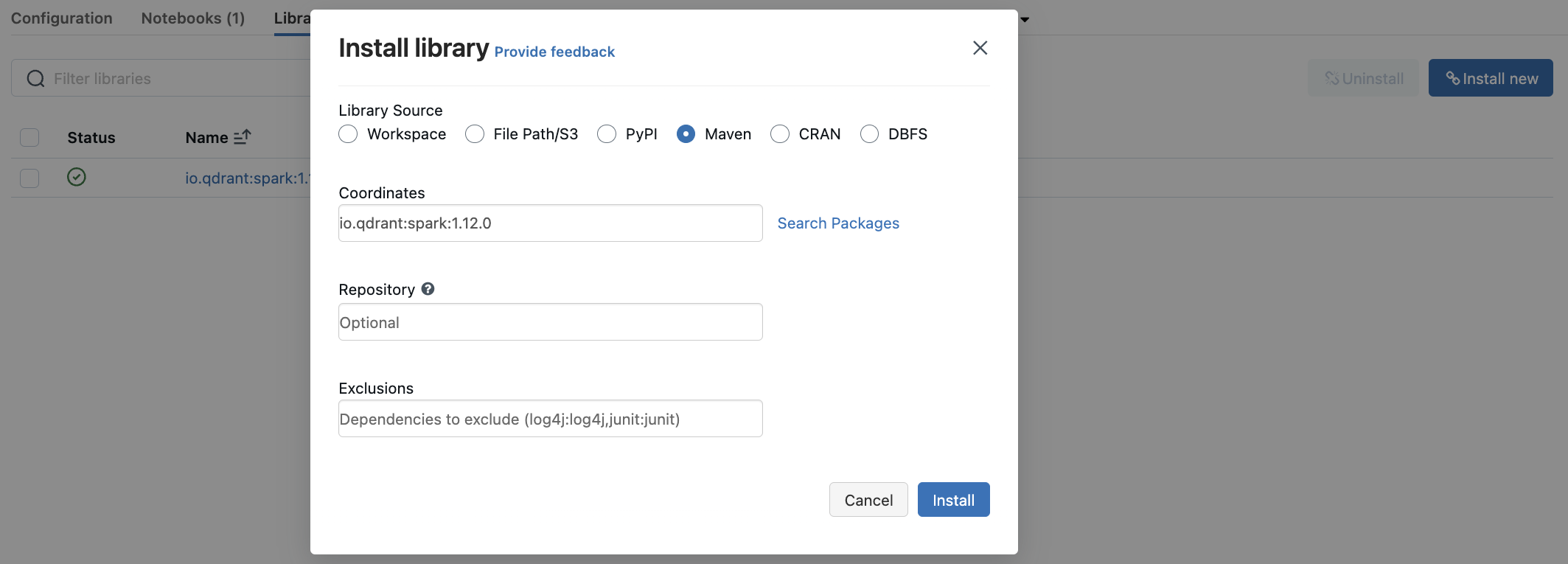Apache Spark
Spark is a distributed computing framework designed for big data processing and analytics. The Qdrant-Spark connector enables Qdrant to be a storage destination in Spark.
Installation
You can set up the Qdrant-Spark Connector in a few different ways, depending on your preferences and requirements.
GitHub Releases
The simplest way to get started is by downloading pre-packaged JAR file releases from the GitHub releases page. These JAR files come with all the necessary dependencies.
Building from Source
If you prefer to build the JAR from source, you’ll need JDK 8 and Maven installed on your system. Once you have the prerequisites in place, navigate to the project’s root directory and run the following command:
mvn package
This command will compile the source code and generate a fat JAR, which will be stored in the target directory by default.
Maven Central
For use with Java and Scala projects, the package can be found here.
Usage
Below, we’ll walk through the steps of creating a Spark session with Qdrant support and loading data into Qdrant.
Creating a single-node Spark session with Qdrant Support
To begin, import the necessary libraries and create a Spark session with Qdrant support:
from pyspark.sql import SparkSession
spark = SparkSession.builder.config(
"spark.jars",
"spark-VERSION.jar", # Specify the downloaded JAR file
)
.master("local[*]")
.appName("qdrant")
.getOrCreate()
import org.apache.spark.sql.SparkSession
val spark = SparkSession.builder
.config("spark.jars", "spark-VERSION.jar") // Specify the downloaded JAR file
.master("local[*]")
.appName("qdrant")
.getOrCreate()
import org.apache.spark.sql.SparkSession;
public class QdrantSparkJavaExample {
public static void main(String[] args) {
SparkSession spark = SparkSession.builder()
.config("spark.jars", "spark-VERSION.jar") // Specify the downloaded JAR file
.master("local[*]")
.appName("qdrant")
.getOrCreate();
}
}
Loading data into Qdrant
The connector supports ingesting multiple named/unnamed, dense/sparse vectors.
Click each to expand.
Unnamed/Default vector
<pyspark.sql.DataFrame>
.write
.format("io.qdrant.spark.Qdrant")
.option("qdrant_url", <QDRANT_GRPC_URL>)
.option("collection_name", <QDRANT_COLLECTION_NAME>)
.option("embedding_field", <EMBEDDING_FIELD_NAME>) # Expected to be a field of type ArrayType(FloatType)
.option("schema", <pyspark.sql.DataFrame>.schema.json())
.mode("append")
.save()
Named vector
<pyspark.sql.DataFrame>
.write
.format("io.qdrant.spark.Qdrant")
.option("qdrant_url", <QDRANT_GRPC_URL>)
.option("collection_name", <QDRANT_COLLECTION_NAME>)
.option("embedding_field", <EMBEDDING_FIELD_NAME>) # Expected to be a field of type ArrayType(FloatType)
.option("vector_name", <VECTOR_NAME>)
.option("schema", <pyspark.sql.DataFrame>.schema.json())
.mode("append")
.save()
NOTE
The
embedding_fieldandvector_nameoptions are maintained for backward compatibility. It is recommended to usevector_fieldsandvector_namesfor named vectors as shown below.
Multiple named vectors
<pyspark.sql.DataFrame>
.write
.format("io.qdrant.spark.Qdrant")
.option("qdrant_url", "<QDRANT_GRPC_URL>")
.option("collection_name", "<QDRANT_COLLECTION_NAME>")
.option("vector_fields", "<COLUMN_NAME>,<ANOTHER_COLUMN_NAME>")
.option("vector_names", "<VECTOR_NAME>,<ANOTHER_VECTOR_NAME>")
.option("schema", <pyspark.sql.DataFrame>.schema.json())
.mode("append")
.save()
Sparse vectors
<pyspark.sql.DataFrame>
.write
.format("io.qdrant.spark.Qdrant")
.option("qdrant_url", "<QDRANT_GRPC_URL>")
.option("collection_name", "<QDRANT_COLLECTION_NAME>")
.option("sparse_vector_value_fields", "<COLUMN_NAME>")
.option("sparse_vector_index_fields", "<COLUMN_NAME>")
.option("sparse_vector_names", "<SPARSE_VECTOR_NAME>")
.option("schema", <pyspark.sql.DataFrame>.schema.json())
.mode("append")
.save()
Multiple sparse vectors
<pyspark.sql.DataFrame>
.write
.format("io.qdrant.spark.Qdrant")
.option("qdrant_url", "<QDRANT_GRPC_URL>")
.option("collection_name", "<QDRANT_COLLECTION_NAME>")
.option("sparse_vector_value_fields", "<COLUMN_NAME>,<ANOTHER_COLUMN_NAME>")
.option("sparse_vector_index_fields", "<COLUMN_NAME>,<ANOTHER_COLUMN_NAME>")
.option("sparse_vector_names", "<SPARSE_VECTOR_NAME>,<ANOTHER_SPARSE_VECTOR_NAME>")
.option("schema", <pyspark.sql.DataFrame>.schema.json())
.mode("append")
.save()
Combination of named dense and sparse vectors
<pyspark.sql.DataFrame>
.write
.format("io.qdrant.spark.Qdrant")
.option("qdrant_url", "<QDRANT_GRPC_URL>")
.option("collection_name", "<QDRANT_COLLECTION_NAME>")
.option("vector_fields", "<COLUMN_NAME>,<ANOTHER_COLUMN_NAME>")
.option("vector_names", "<VECTOR_NAME>,<ANOTHER_VECTOR_NAME>")
.option("sparse_vector_value_fields", "<COLUMN_NAME>,<ANOTHER_COLUMN_NAME>")
.option("sparse_vector_index_fields", "<COLUMN_NAME>,<ANOTHER_COLUMN_NAME>")
.option("sparse_vector_names", "<SPARSE_VECTOR_NAME>,<ANOTHER_SPARSE_VECTOR_NAME>")
.option("schema", <pyspark.sql.DataFrame>.schema.json())
.mode("append")
.save()
No vectors - Entire dataframe is stored as payload
<pyspark.sql.DataFrame>
.write
.format("io.qdrant.spark.Qdrant")
.option("qdrant_url", "<QDRANT_GRPC_URL>")
.option("collection_name", "<QDRANT_COLLECTION_NAME>")
.option("schema", <pyspark.sql.DataFrame>.schema.json())
.mode("append")
.save()
Databricks
You can use the qdrant-spark connector as a library in Databricks.
- Go to the
Librariessection in your Databricks cluster dashboard. - Select
Install Newto open the library installation modal. - Search for
io.qdrant:spark:VERSIONin the Maven packages and clickInstall.

Datatype Support
Qdrant supports all the Spark data types, and the appropriate data types are mapped based on the provided schema.
Configuration Options
| Option | Description | Column DataType | Required |
|---|---|---|---|
qdrant_url | GRPC URL of the Qdrant instance. Eg: http://localhost:6334 | - | ✅ |
collection_name | Name of the collection to write data into | - | ✅ |
schema | JSON string of the dataframe schema | - | ✅ |
embedding_field | Name of the column holding the embeddings | ArrayType(FloatType) | ❌ |
id_field | Name of the column holding the point IDs. Default: Random UUID | StringType or IntegerType | ❌ |
batch_size | Max size of the upload batch. Default: 64 | - | ❌ |
retries | Number of upload retries. Default: 3 | - | ❌ |
api_key | Qdrant API key for authentication | - | ❌ |
vector_name | Name of the vector in the collection. | - | ❌ |
vector_fields | Comma-separated names of columns holding the vectors. | ArrayType(FloatType) | ❌ |
vector_names | Comma-separated names of vectors in the collection. | - | ❌ |
sparse_vector_index_fields | Comma-separated names of columns holding the sparse vector indices. | ArrayType(IntegerType) | ❌ |
sparse_vector_value_fields | Comma-separated names of columns holding the sparse vector values. | ArrayType(FloatType) | ❌ |
sparse_vector_names | Comma-separated names of the sparse vectors in the collection. | - | ❌ |
shard_key_selector | Comma-separated names of custom shard keys to use during upsert. | - | ❌ |
For more information, be sure to check out the Qdrant-Spark GitHub repository. The Apache Spark guide is available here. Happy data processing!























